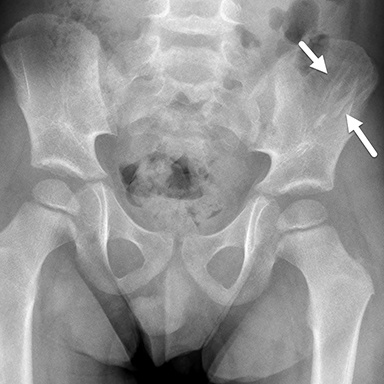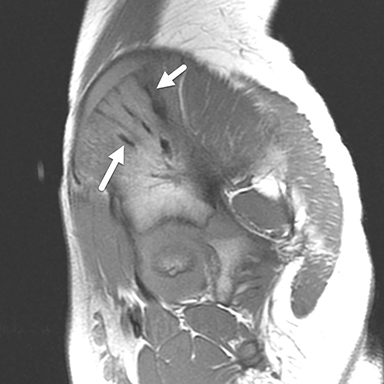Osteopathia striata
Images


CASE SUMMARY
A 3-year-old male with history of autism fell down the stairs. The child was limping and refused to bear weight after the fall. Hip radiographs which included the pelvis were obtained to exclude fracture.
IMAGING FINDINGS
On frontal hip radiographs, no fracture was present. Incidentally, linear areas of sclerosis were present in the left iliac wing, radiating from the middle portion of the iliac wing towards the crest (Figure 1).
Despite no traumatic abnormality, the etiology of the sclerosis was uncertain. At this time, the differential diagnosis included artifact, prior trauma, bone dysplasia, and neoplasm. An MRI scan of the pelvis without contrast was obtained because neoplasm remained in the differential diagnosis. The exam showed the serpiginous areas of marked T1 and T2 hypointensity in the left iliac wing corresponding to the linear areas of sclerosis on the radiograph (Figure 1). The serpiginous markings matched the signal of cortical bone and were oriented in a fan like distribution parallel to the long axis of the iliac bone.
DIAGNOSIS
Osteopathia striata of the iliac bone
DISCUSSION
Osteopathia striata, also known as Voorhoeve’s Disease, is a benign autosomal dominant or sporadically inherited disorder in bone formation first described by Voorhoeve in 1924.1 Although it most commonly occurs within the metaphyses of long bones in areas of rapid growth, osteopathia striata may potentially occur in all bones except the clavicles and the skull. Pathologically, it is caused by a failure in remodeling of persistent mature bone.2
Ostoepathia striata is a benign, asymptomatic finding that should be considered incidental in the vast majority of cases. It is rarely associated with other sclerosing bone dysplasias such as melorheostosis and osteopoikilosis. When two bone dysplasias are found together, they are known as “overlap syndromes” and can be symptomatic.3
Typically, osteopathia striata is diagnosed based on its characteristic findings on imaging. The hallmark of the disorder is dense linear striations occurring typically in the metaphysis or diaphysis of long bones.1 The striations vary in length depending on the growth rate of the affected long bone.1 Therefore, the striations are longest in the femurs. If the pelvis is involved, the striations have a fan-like appearance. Most cases of osteopathia striata affect multiple bones and are bilateral.1 There is no increased uptake within striations on bone scan.3
Osteopathia striata is occasionally associated with other syndromes. One rare association is with sclerosis of the cranial vault or skull base as part of an inherited syndrome called osteopathia striata with cranial sclerosis. This rare syndrome has been reported in approximately 100 patients and is thought to be inherited in an autosomal dominant or possibly x-linked dominant fashion. The syndrome has a variable phenotype which can include deafness, cranial nerve palsies, minor anatomic anomalies, and mental retardation.4,5 In osteopathia striata with cranial sclerosis, the tell-tale linear striations of OS in the long bones are not evident at birth, but become visible between 5 months and 6 years of age.3
Osteopathia striata should be recognized by the radiologist as a “don’t touch” lesion. Although readily identified in the long bones, when it occurs in less common sites, such as the iliac bones, it may be more challenging to diagnose. The fan-like appearance of the striations seen in the iliac bones in this case has been previously described on radiography, with the orientation of the striations mirroring the growth of the bone.2 In that case, the linear striations were more apparent using cross-sectional imaging and the correct diagnosis was able to be made.
CONCLUSION
Osteopathia striata is a benign entity, although rarely it may be associated with other slerosing dysplasias or disorders. Consider the diagnosis even in unusual sites such as the iliac bones if linear striations of cortical bone are evident.
REFERENCES
- Gehweiler JA, Bland WR, Carden TS Jr, Daffner RH. Osteopathia striata—Voorhoeve’s disease. Review of the roentgen manifestations. Am J Roentgenol Radium Ther Nucl Med. 1973 Jun;118(2):450-455.
- Greenspan A. Sclerosing bone dysplasias--a target-site approach. Skeletal Radiol. 1991;20(8):561-583.
- Vanhoenacker FM, De Beuckeleer LH, Van Hul W, Balemans W, Tan GJ, Hill SC, De Schepper AM. Sclerosing bone dysplasias: genetic and radioclinical features. Eur Radiol. 2000;10(9):1423-1433.
- Magliulo G, Parrotto D, Zicari AM, Zappala D, Lo Mele L, Primicerio P, Marini M. Osteopathia striata-cranial sclerosis: otorhinolaryngologic clinical presentation and radiologic findings. Am J Otolaryngol. 2007 Jan-Feb;28(1):59-63.
- Viot G, Lacombe D, David A, Mathieu M, de Broca A, Faivre L, Gigarel N, Munnich A, Lyonnet S, Le Merrer M, Cormier-Daire V. Osteopathia striata cranial sclerosis: non-random X-inactivation suggestive of X-linked dominant inheritance. Am J Med Genet. 2002; Jan 1;107(1):1-4.
Citation
C F, RB T, AJ T.Osteopathia striata. Appl Radiol. 2019; (2):38-39.
March 28, 2019